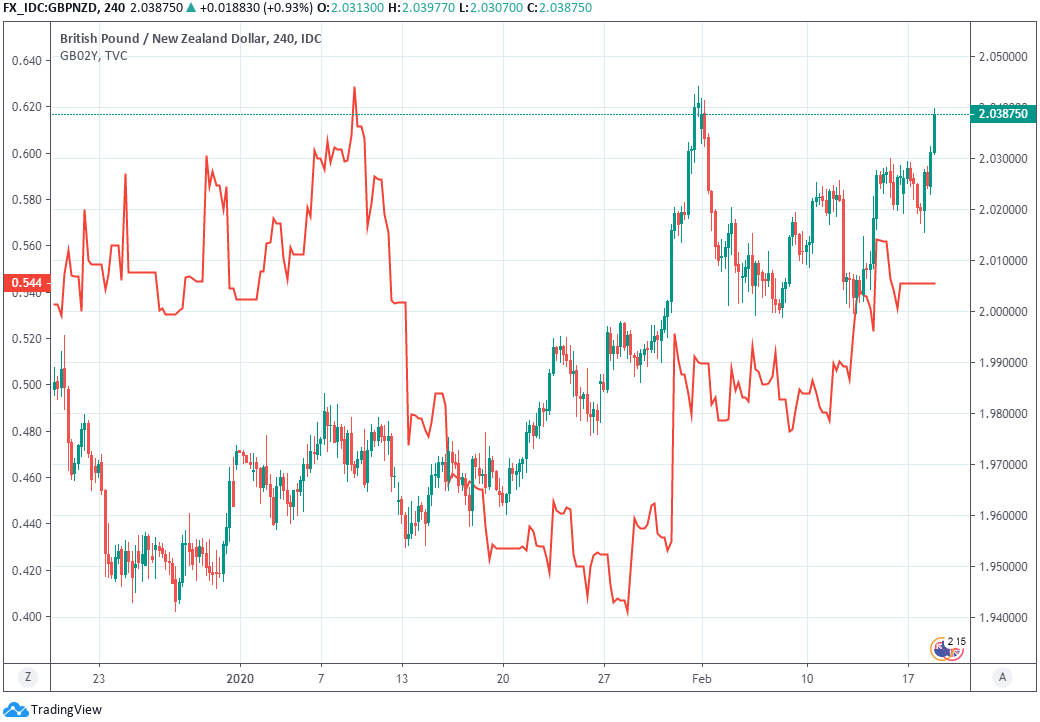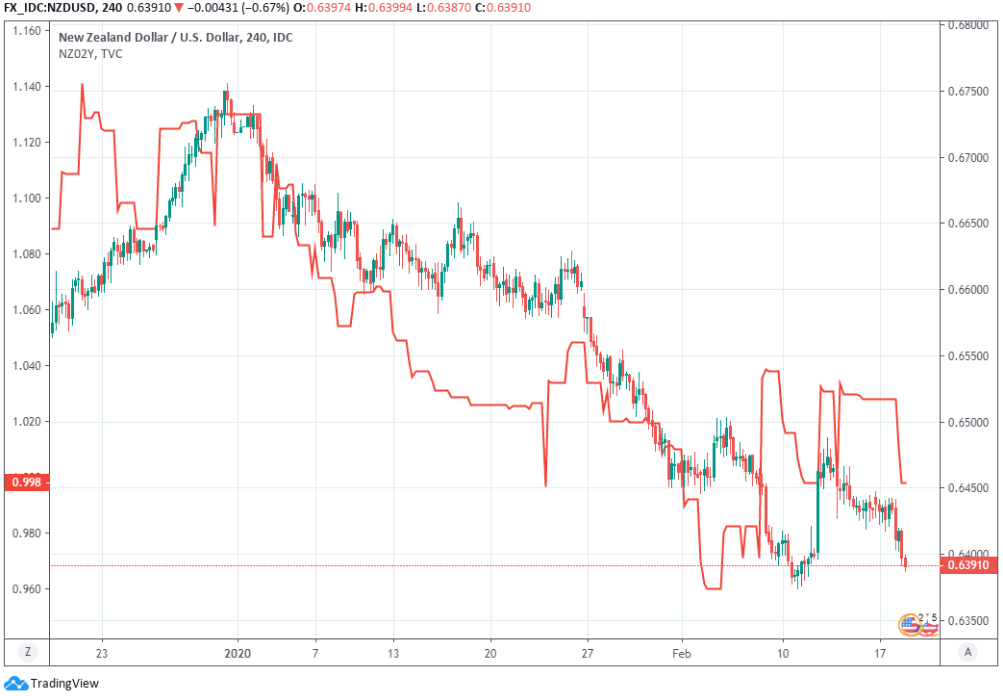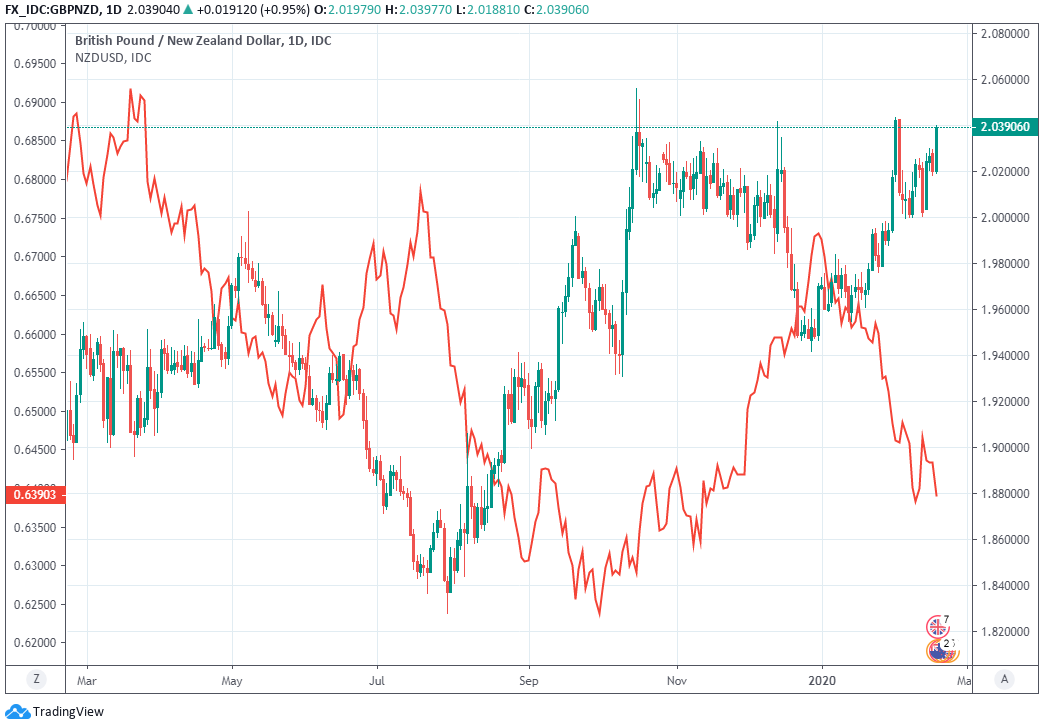Pound-to-New Zealand Dollar Rate Aims at New Highs as Virus Fears Hit Kiwi Exchange Rates
- Written by: James Skinner
- NZD underperforms as coronavirus fallout hits the CNH.
- Apple's profit warning sees fears for Asia economies rise.
- PBoC confounds market by withdrawing monetary stimulus.
- But more downside seen ahead as virus impact crystalises.
- CNH breaks 7.0, NZD/USD breaks 0.64, GBP/NZD eyes 2.0441.

© Naru Edom, Adobe Stock
- GBP/NZD Spot Rate: 2.0387, up -0.93% today
- Indicative bank rates for transfers: 1.9677-1.9820
- Indicative broker rates for transfers: 2.0085-2.0207 >> find out more about this rate.
The Pound-to-New Zealand Dollar rate was aiming at a fresh post-referendum high Tuesday as the Kiwi underperformed over concerns about the economic impact of coronavirus, which have prompted notable losses for China's Yuan.
New Zealand's Dollar lost ground to all other than the oil-sensitive Norwegian Krone Tuesday after China's Yuan fell back through the landmark 7.0 level against the U.S. Dollar in response to mounting concerns over the possible fallout from the coronovirus crisis in the world's second largest economy.
Weakness in New Zealand's currency is helping to the keep the Pound-to-New Zealand Dollar pair on the upward trajectory that's characterised trading in the exchange rate since the summer last year, although it's now within inches of scoring a fresh post-referendum high. Gains were aided by Sterling strength after the British unit was lifted by a stronger-than-expected January jobs report.
Tuesday's UK labour market report helped keep 2-year British government bond yields stable on a morning when all other short-term bond yields were bleeding lower in response to the fresh signs that coronavirus is having a debilitating impact on companies and economies. Sterling's gains have left it within inches of the 2.0441 post-referendum peak reached late in January and came as the New Zealand Dollar fell in sympathy with the Chinese Yuan.
Above: Pound-to-New Zealand Dollar rate shown at 4-hour intervals, alongside 2-year GB bond yield (red line, left axis).
China's Yuan fell overnight after Apple told investors it will not meet revenue guidance because of virus-related disruptions to its business in China. The Kiwi has a strong, positive correlation with the Yuan because of the significant commodity trade between the two countries so it was immediately impacted when the USD/CNH rate rose above the psychologically important 7.0 level.
"Work is starting to resume around the country, but we are experiencing a slower return to normal conditions than we had anticipated. As a result, we do not expect to meet the revenue guidance we provided for the March quarter due to two main factors. The first is that worldwide iPhone supply will be temporarily constrained...The second is that demand for our products within China has been affected," - Apple Inc.
Tuesday's mood became even more downbeat, exacerbating the Kiwi's losses, when South Korean President Moon Jae-in said his country faces an economic emergency in addition to a deadly threat from the coronavirus that's brought much of China to a standstill this year. He called for "preemptive and extraordinary measures for both public safety and people's livelihoods," when delivering opening remarks to the 7th Cabinet Meeting.
"NZD/USD drifted lower under 0.6400 because of worsening financial market sentiment. Today’s fortnightly Global Dairy Trade auction risk adding more downside pressure on NZD/USD. Whole Milk Powder (WMP) prices are expected to fall again in reaction to the coronavirus outbreak. China is the world’s largest dairy importer and the largest buyer on the GDT platform. China accounted for around a third of NZ dairy export values in 2019. Futures market pricing points to a WMP price fall of around 2.5%," warns Elias Haddad, a strategist at Commonwealth Bank of Australia.
Above: NZD/USD rate shown at 4-hour intervals, alongside 2-year NZ bond yield (red line, left axis).
Many economies including that of Japan, the world's third largest, already had a torrid time in the final quarter. Japan's economy contracted by an annualised -6.3% in the as households protested a sales tax increase by cutting back consumption, so another contraction this quarter would leave the world's third largest economy mired in a technical recession.
"I ask you to work out preemptive and extraordinary measures for both public safety and people’s livelihoods...While doing its utmost to control and prevent an epidemic, the Government should deal sternly with what is transpiring with a sense of urgency that we are in an emergency economic situation caused by economic repercussions from the COVID-19 outbreak. Korea is bound to bear the brunt of a slump in the Chinese economy," - President Moon Jae-in.
New Zealand has not been left unscathed by the virus either because travel pans implemented by the coalition government, not to mention the virus itself, are severely hampering tourism flows into the country. Health Minister David Clark said Saturday that entry bans for anyone " travelling from, or transiting through, mainland China" have been extended for a further eight days.
Tourism is a significant Kiwi industry and China a major source of tourist spending, although this is just one of the multiple pathways through which the commodity-heavy Kiwi economy could be impacted by the virus. Global markets have so-far erred on the side of optimism about the possible economic impact of the virus that's infected more than 70,000 people in China and elsewhere within less than a month of it being declared an issue by Chinese authorities.
Above: Pound-to-New Zealand Dollar rate at daily intervals, alongside NZD/USD rate (red line, left axis).
Efforts to fight the virus have gotten entire cities of many millions of people put into 'lock-down' with citizens unable to leave home, which has seen consumers prevented from spending and workers idled. Containment measures have brought China's manufacturing powerhouse of an economy to a standstill which is now having a significant impact on the supply chains of multinational companies the world over.
The virus fallout is crystalising at a bad time for the New Zealand Dollar, which has risen strongly into the New Year as markets spied signs of an anitpodean economic recovery that led investors to price-out from money markets much of the implied probability of further interest rate cuts from the Reserve Bank of New Zealand (RBNZ) this year.
The RBNZ encouraged this view itself last week.
New Zealand's Dollar was lifted in recent months as the pricing in the overnight-index-swap market shifted from implying a November 11 cash rate of just 0.49% back in October, to an implied cash rate of 0.81% on Tuesday.
Current pricing implies close to an 80% probability of one rate cut by year-end when previously it had seen two cuts as a done deal, although that recent trend could go into reverse and weigh on the Kiwi if the impact of coronavirus is larger than markets and the RBNZ currently expect.
"Pricing for RBNZ implies a 10% chance of easing at the next meeting on 25 March, with a terminal rate of 0.88% (RBNZ OCR currently at 1.0%)," says Imre Speizer, an NZ strategist at Westpac. "Our RBNZ OCR forecast continues to expect a rate cut to 0.75% in August, followed by a long period on hold. While we expect a solid domestic economy this year, the global economy is expected to slow, notably in the US, which will cause the Fed to cut its policy rate."







